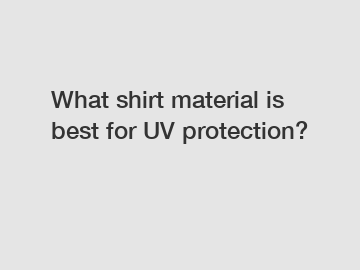Jan. 27, 2024
Fashion Accessories
As the world becomes more aware of the harmful effects of sun exposure, finding ways to protect ourselves from harmful UV rays has become paramount. Sunscreen is often our first line of defense, but did you know that the clothes we wear also play a crucial role in shielding us from the sun's damaging rays? In this blog post, we will explore the best shirt materials for UV protection and help you make an informed decision about what to wear.
When it comes to choosing the right shirt material for UV protection, not all fabrics are created equal. Some fabrics may provide minimal sun protection, while others act as a strong barrier against harmful UV radiation. Here are a few materials that are known for their excellent UV protection properties:
1. Natural fibers like cotton and linen: Cotton and linen are commonly used in clothing due to their breathable and lightweight nature. However, their ability to provide UV protection is limited. On average, cotton shirts offer an Ultraviolet Protection Factor (UPF) of about 5, which means that only 1/5th of the sun's UV rays are blocked. Therefore, while cotton and linen shirts may feel comfortable, they are not the best choice for UV protection.

2. Synthetic fibers like polyester and nylon: Synthetic fabrics are often recommended for their enhanced UV protection capabilities. Polyester and nylon fabrics typically have a higher UPF than natural fibers, ranging anywhere from 15 to 50+. These materials are known for their durability and water resistance, making them ideal for outdoor activities like hiking or swimming. However, it is important to note that the level of UV protection offered by synthetic fibers can vary based on factors such as fabric thickness and color.
3. High-tech fabrics: In recent years, there has been a surge in the development of high-tech fabrics specifically designed for UV protection. One such fabric is called UPF fabric, which is tightly woven and treated with UV-blocking additives during the manufacturing process. UPF fabric provides excellent protection against both UVA and UVB rays. T-shirts made from UPF fabric often have a UPF rating of 50+ and offer the highest level of UV protection. These shirts are not only functional but also stylish, making them a popular choice for outdoor enthusiasts.
4. Dark-colored clothing: While not a specific fabric, the color of your shirt plays a crucial role in its UV protection properties. Dark-colored clothing, especially black, navy blue, and deep red, absorbs rather than reflects UV rays, providing better protection compared to lighter colors. A study conducted by the University of Queensland found that dark-colored cotton shirts had an average UPF of 14, while light-colored shirts had an average UPF of only 4. However, it is always essential to consider the fabric in conjunction with the color for optimal UV protection.
When shopping for UV-protective clothing, it's essential to look for labels or tags indicating the UPF rating. The UPF rating provides information about the level of UV protection a fabric offers, with a higher rating indicating better protection. Aim for shirts with a UPF rating of 50+ for maximum protection.
In addition to wearing the right material, here are a few additional tips to enhance your overall sun protection:
- Wear wide-brimmed hats and sunglasses to shield your face and eyes from the sun's rays.
- Apply sunscreen generously to any exposed skin, even if you're wearing UV-protective clothing.
- Seek shade when the sun is at its strongest (usually between 10 am and 4 pm).
Remember, protecting your skin from harmful UV rays is crucial for maintaining healthy skin and reducing the risk of sunburn, premature aging, and skin cancer. By choosing the right shirt material with proper UV protection and adopting sun-safe practices, you can enjoy the outdoors without compromising your skin's health.
In conclusion, when it comes to UV protection, not all shirt materials are created equal. While natural fibers like cotton and linen offer limited protection, synthetic fibers like polyester and nylon provide better UV shielding. High-tech fabrics, such as UPF fabric, offer the highest level of protection, while dark-colored clothing can also enhance UV resistance. By considering these factors and incorporating sun-safe practices, you can ensure that you're minimizing your risk of sun-related skin damage. Stay safe, stay stylish, and enjoy the outdoors responsibly!
For more information, please visit winter jacket manufacturers china, coated bag shijiazhuang, baby sun safe swimwear.
If you are interested in sending in a Guest Blogger Submission,welcome to write for us!
All Comments ( 0 )